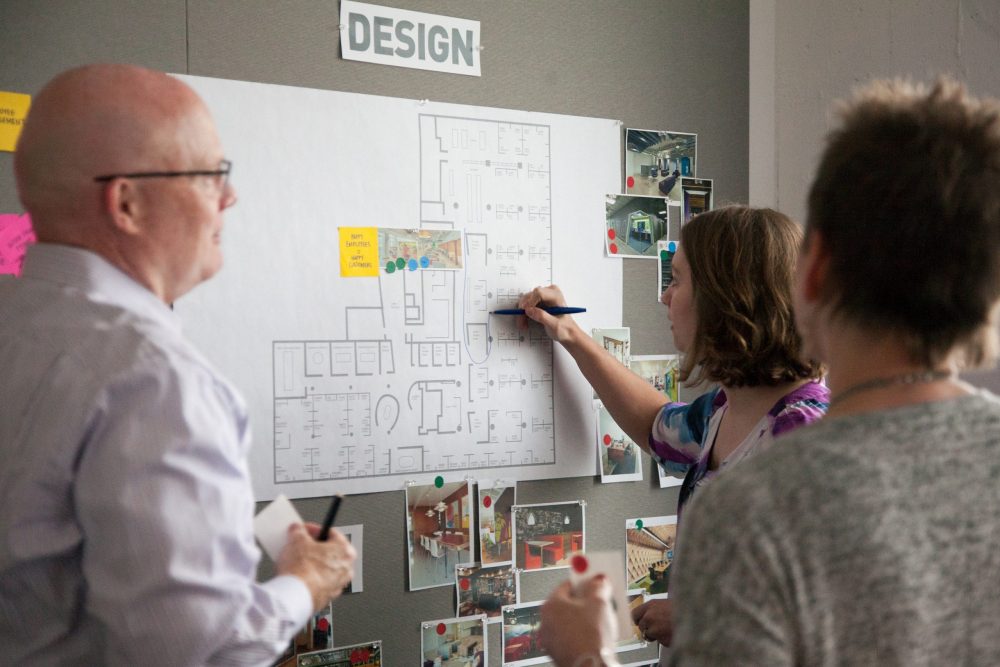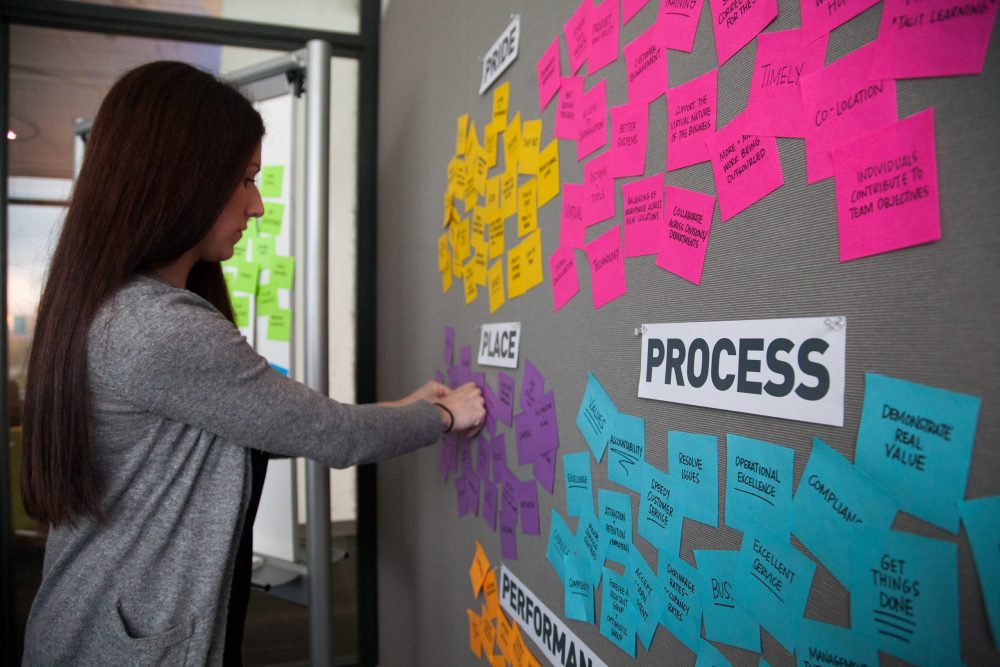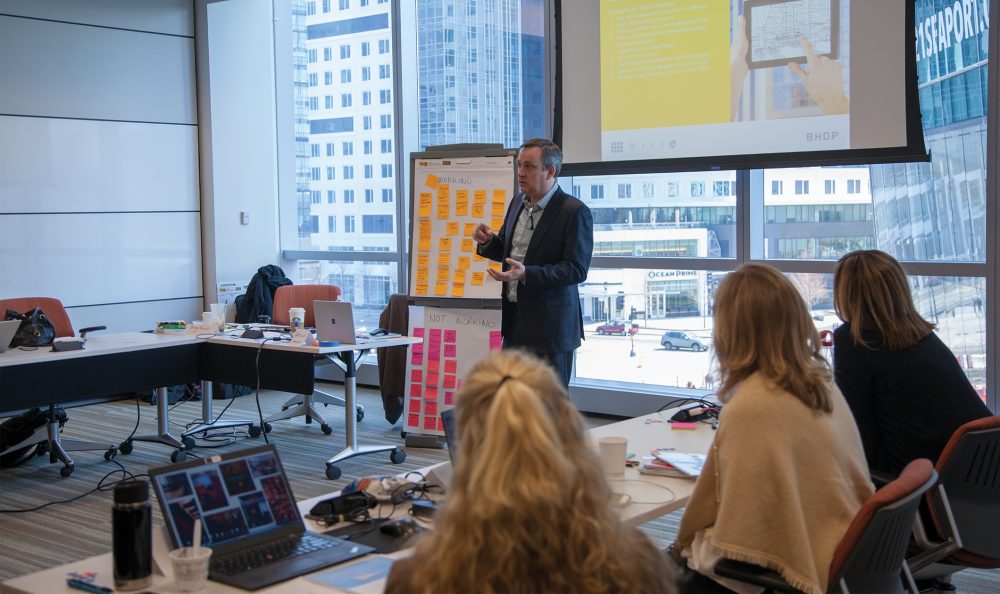Successful implementation of a change management plan requires change leadership skills that smooth the way for all parties when most needed—at the inception.

Here’s a typical scenario. An organization’s leadership creates a vision for a dynamic new workplace design, now awaiting construction. When the vision is shared, it will require a need for change management. As a result, the work environment can become unsettled. It’s just human nature. Any modification in an established routine or process, especially one that has long been accepted, is bound to elicit a variety of emotional responses ranging from skepticism to hostility. The visceral reaction is understandable. Change may be constant in this fast-paced world, but that doesn’t mean everyone is prepared for the inevitability. Change management is often viewed as one more dictate from leadership to accept the vision and “go with the flow.”
This scenario illustrates what is wrong with a conventional approach to change management. Employees are informed after the fact without proper context: no explanation about either the reasons for the decision or its impact on every organization member. Design and other departments associated with workspace understand why it makes more sense to get buy-in from the get-go before change management takes place. While major changes in policies and procedures are the province of higher management, their successful implementation requires change leadership skills that smooth the way for all parties when most needed—at the inception.
The difference and its impact
Those steeped in the traditional especially in the work design world consider change leadership and change management synonymous. Often the attempts to differentiate them are viewed as nothing more than time-wasting semantic exercises. That’s far from accurate. One is a process and the other, the strategy that guides it. Change management represents the former. This team has a sole purpose: to manage execution of the changes ordered by higher management. Assuming that is the case, what is the point of discussing change leadership if the term is just a euphemism for senior management? It’s more than that.
Change leadership is strategic in nature. It sets the direction for change management. The first focus of a change leadership team is effective and purposeful communication disseminated much like any outreach initiative. Instead of a top-down approach, it is more effective for the team to focus on informing and educating the workforce, if it expects to diminish negative reactions. Incumbent upon the leadership team is the clear representation of the benefits of a proactive change management approach with participation from design and other departments. Such parameters need to be set by change leaders committed to avoiding the appearance of arbitrary decisions likely to ruffle the feathers of every department kept out of the loop.
That’s not to suggest that even if consulted, workplace designers and others will willingly and unquestioningly march in time to the beat of change management’s drummers. It’s one thing to change a process; it’s another to change someone’s space. People often equate their work and workplace with their self-image, which explains why so many take process and workplace changes personally. Consider it one more manifestation of the ancient “fight or flight” mentality and the need to protect what we believe is our territory.
A recent focus group verified the role of self-image with workspace. Most group participants, millennials in particular, connected workspace with their identity. One respondent said he felt “entitled” to the space he has now, but possibly could learn to “become entitled” if the workspace was subsequently changed. Regardless of one’s opinion about such attitudes, these feelings amount to a mixed bag and another potential stumbling block, a situation likely to occur when the chain of communications is broken. Little wonder why fear follows absence of information.

Change initiatives and successful integration
Change initiative components, strategy, workplace design and change management, need to be integrated and supported. Strategy develops the vision and sets the criteria for success. Design makes the abstract real, but that may not be enough as change leadership should understand. Design, too, needs to be fully aware of the change and, in particular, its rationale. In this change leadership paradigm, the role of change management expands. Now its mission is to mesh all components so that vision and implementation are successful. One does not usually equate a teamwork environment with traditional change management, but that is what change leadership must advocate.
Communication is the foundation of teamwork environment in this and practically every scenario. When communications do not effectively convey reasoning, purpose and benefits such as improving work processes and cost efficiencies, detrimental misunderstandings may result. Efficient and successful change enterprises should also avoid departmental silo mentalities. Yes, departments still work separately, but the goal is to work well with each other meaning that change management cannot be at odds with everyone else. The scenario can seem utopian and probably far-fetched to those who have suffered through a top-down, dictatorial process. Yet it can come to fruition starting with a change management call for input from work design. The change management team should explain the cost, rationale and benefit to the company and department, and encourage feedback and open dialogue. The team can help build support by pointing out opportunities that design has not considered or is not able to fully address without supportive policy changes.
In one recent example, a change management team was able to identify a need to address lack of storage space—a point omitted by work design during its presentation. The client had moved to an unassigned desking model with no storage at the workstations and an inadequate number of lockers. During change advocate focus groups, employees voiced their needs to store personal items like purses, food items and coats. The result: more lockers added to the design with each employee getting an assigned locker establishing a better and personal connection to the space.

Leave the egos at the door
For design and space changes to work, all parties must leave their egos at the door—a point to be emphasized by change leadership for facilitating an environment of openness and information accessibility. Not everyone will be on the same page at the outset because various parties may be at different stages of the process, such as work design at the beginning and other departments later. To help alleviate these obstacles, change leadership should organize a group of change advocates. These can be representatives from each department who are trustworthy and approachable. The advocates can provide regular updates to peers and encourage questions to resolve any concerns or misinformation issues.
None of this takes place in a vacuum. Naturally, some companies may want to examine how these efforts paid off for other organizations, but there is a caveat: what works elsewhere may not mesh with the corporate culture. Perhaps the classic example is an effort by one technical services company to try to duplicate a Silicon Valley success story in which all work- spaces were opened to facilitate responses to product demand. It worked there, but unfortunately not here. The attempt failed and actually hampered productivity, forcing the organization to modify its space usage proving that the best efforts of change leadership can run aground if cultural issues are unaddressed.

Adopt the best practices
In a 2018 study, “The Best Practices of Change Management,” published by Prosci, the company tabulated survey data from 6,000 respondents gleaned over a 20-year period. One finding is of special note. Middle managers were identified as “most resistant to change,” but according to survey results, resistance can be “mitigated” by “thoroughly addressing” it when developing the change plan.
That’s one more justification for a project champion with a clear vision to communicate with all participants. The leader communicates understanding that any initiative impacting design of workspace without communication, integration and empathy with those who design it and other affected departments cannot reasonably expect enthusiastic acceptance. The key is to get all involved in the process early on. That means a thorough, up-front explanation of the business driver, particularly an emphasis on the best use of space in terms of functions and operational cost.
When change leadership ensures those messages are sent, received and even welcomed, process change is likely to overcome its biggest hurdles, particularly the relationship between work design and change management. Work design output is meant to endure and yet remain flexible for inevitable modifications years later requiring cooperation among all parties. Everyone needs to play well in this process change sandbox.

